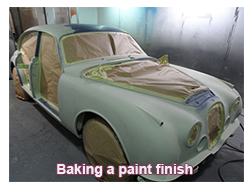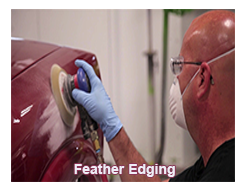
ADHESION:
ELECTROSTATIC POWDER COATING (EPC): Describes a method of painting car bodies in which the outer parts of the body shell are coated with a powder dispersion by means of cathodic immersion, and the cavities are coated with cathodic electro paint.
ACRYLIC FINISH: Describes the final coating of acrylic paint where the pigment and an acrylic paint are mixed together.
BAKE: Describes the process of curing or drying paint by using heat
BAKING TEMPERATURE: Describes the temperature at which a varnish or paint must be baked in order to develop desired final properties of strength and hardness
BASE AND CLEAR SYSTEM: Describes a paint finish made up from a coloured base coat (usually a metallic finish) and clear lacquer coat.
BASE COAT: Describes the first coat in a paint system that can either be the undercoat or primer or a coloured coat later covered by clear lacquer.
BLOCK SANDING: Describes the process in which a wooden block wrapped in sandpaper is used to sand material.
BUFFING: Describes the procedure of smoothing and polishing a surface by using a buffing wheel and polishing paste or liquid.
BRIDGING: Describes the characteristic of undercoats that occurs when a scratch or other imperfection in the surface isn't completely filled due to under-reducing the primer or using a solvent that dries too fast.
BURNISH: Describes the procedure of bringing a paint surface to a high shine by rubbing with a hard, smooth object.
CATHODIC ELECTROPAINTING: Describes the process of applying the first coat of paint to the body of a car by positively charging the paint particles and then dunking the metal into the paint.
COLD SPRAYING: Describes a method of paint spraying where the paint is excessively diluted with solvent. This process makes spraying easy, but the coats are very light.
COVERAGE: Describes the surface area that a given quantity of paint will cover adequately.
CROSS COAT: Describes a paint spraying technique in which consecutive coats are sprayed at right angles to one another.
DEWAX: Describes the procedure of removing a coating of wax from the body of a vehicle before painting.
DIE-BACK: Describes a procedure that occurs when applying a lacquer finish the loss of gloss after compounding is caused by continued evaporation of thinner.
DOUBLE COAT: Describes the application of two single coats of either primer or paint little or no flash time between them.
DRY SPRAY: Describes a fault in vehicle spraying where the paint pigment where the binder evaporates before the paint reaches the surface. Dry spray is caused either by holding the spray gun too far from the item being sprayed or applying too much air pressure or using a solvent that evaporates too fast.  Denotes the ability of paint, primer, or glue to stick to the surface to which it is applied.
Denotes the ability of paint, primer, or glue to stick to the surface to which it is applied.
ELECTROSTATIC PAINTING: Describes a method of painting car bodies using the particle- attracting property of electrostatic charges, in which a direct current is applied to a grid of wires through which the paint is sprayed to charge each particle.
ELECTROPHORETIC PAINTING: Describes a process used to apply the first coat of paint (primer) to car bodies, in which negatively charged paint particles (anodic electropainting) or positively charged paint particles (cathodic electropainting are immersed in a tank of electrodeposition paint, and the current is turned on, so that the paint particles are attracted by the positively charged paint particles.
EMERY CLOTH: Describes a cloth coated in emery crystals like fine sandpaper for use as an abrasive on metals
FILLER: Describes a type of paste usually with a polyester base that when mixed with a hardener forms a surface which can be sanded smooth making it suitable for repairs to dented or rusted bodywork.
FINISHING PAINT: Describes the type of paint used as the topcoat of a painting system -- usually before a clear coat is applied.
FEATHER-EDGE: Describes applying a tapered edge to paint where it meets the metal. The edges are either tapered or slanted so that no edge can be felt.
FEATHERING: Describes a type of tire wear in which the tread is worn down to a very thin edge.
FINISH: Describes the final coat of paint applied to a vehicle.
FLASH: Describes the first stage of the drying process of paint where most of the solvents evaporate.
FOG COAT: Describes a fully reduced paint sprayed at higher than normal air pressure to obtain a fast flash-off (evaporation) of thinner with minimum penetration of thinner into the old paint.
FULL DIP TREATMENT: Describes a painting process in which the whole-body shell is immersed, in order to evenly apply protective primers
GENERAL PURPOSE LACQUER THINNER: Describes a type of thinner suitable to be used for both lacquers and synthetic enamels without causing lifting or other paint faults.
GLASSPAPER: Describes an abrasive paper coated with fine particles of glass, used for smoothing and polishing
GLOSS: Describes the ability of a paint surface to reflect images when polished.
GRIT NUMBER: Denotes the classification of sand paper by fineness of the grit particles.
GUIDE COAT: Describes a thin coat of paint added to highlight imperfections.
HARD ANODIC COATING: Describes a hard, wear-resistant, oxide layer produced in an anodic oxidation process.
HARD ANODISING: Describes a special type of anodizing adapted to the production of thick, hard, abrasion-resistant films.
HARD-DRY: Describes the condition of paint when hard enough to polish.
HARDENING: Describes the hardening process of paint, epoxy, or glue that involves several stages.
HEAVY SIDE PATTERN:  Describes an oval spray pattern that is thicker toward the left- or right-hand side, so that it takes on a crescent shape.
Describes an oval spray pattern that is thicker toward the left- or right-hand side, so that it takes on a crescent shape.
HIGH GLOSS: Describes a paint job with a very shiny finish.
HOT SPRAYING: Describes the procedure of spray processing in which paint is preheated in a container to reduce its viscosity

